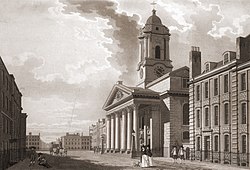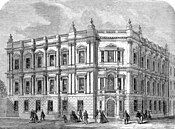St George Hanover Square
| St George Hanover Square | |
|---|---|
Civil parish | |
 The building of the Church of St George's, Hanover Square, prompted the creation of a new parish and select vestry for church and civil purposes | |
 | |
| Area | |
| • 1851 | 1,161 acres (4.70 km2) |
| • 1901 | 1,111 acres (4.50 km2) |
| • 1921 | 1,110 acres (4.5 km2) |
| Population | |
| • 1851 | 73,230 |
| • 1901 | 76,957 |
| • 1921 | 67,280 |
| Density | |
| • 1851 | 63.1/acre |
| • 1901 | 69.3/acre |
| • 1921 | 60.6/acre |
| History | |
| • Preceded by | City of Westminster (parish) |
| Status | Poor law parish (1834–1870) |
| Government | St George Hanover Square Vestry (1724–1900) |
| • Type | Vestry |
| • HQ | Vestry Hall, Mount Street, Mayfair |
| Contained within | |
| • Poor Law Union | St George's (1870–1913) City of Westminster (1913–1922) |
St George Hanover Square was a
Westminster City Council
. The parish continued to have nominal existence until 1922. As created, it was a parish for both church and civil purposes, but the boundaries of the ecclesiastical parish were adjusted in 1830, 1835 and 1865.
Creation
The
sessions
.
Geography
The northern boundary was Bayswater Road and Oxford Street from
Hanover Square was located near to the northeastern boundary. It included within its boundaries the grounds of Buckingham Palace, although the palace itself was in St Martin in the Fields.[6]
Reform
The parish adopted the
ratepayers. The aristocratic dominance of the vestry declined. In 1815, 40% of vestrymen had titles and in 1845 it was half that.[7]
In 1855, the parish vestry became a local authority within the area of responsibility of the Metropolitan Board of Works.
Under the
vestrymen to them: Dover (6), Conduit (9), Grosvenor (12), Brook (15), Curzon (12), Knightsbridge (27) and The Out (27).[8][9]
Ecclesiastical division
It was initially a parish for both ecclesiastical and civil purposes. However, by 1865 it was divided into eleven
ecclesiastical districts.[10]
Poor law
St George was a
St Margaret and St John for this purpose in 1870 as the St George's Union and a board of guardians elected.[11]
Abolition
In 1889 the parish became part of the County of London. The vestry was abolished in 1900 and replaced by Westminster City Council when it became part of the Metropolitan Borough of Westminster. It was abolished as a civil parish in 1922.
Population
| Year | 1801 | 1811 | 1821 | 1831 | 1841 | 1851 | 1871 | 1881 | 1891 | 1901 | 1911 | 1921 |
|---|---|---|---|---|---|---|---|---|---|---|---|---|
| Population[12] | 38,440 | 41,687 | 46,384 | 58,209 | 66,552 | 73,230 | 90,028 | 89,573 | 78,364 | 76,957 | 70,106 | 67,280 |
Notable people
- Lady Amabel Kerr (1846-1906), writer
References
- ^ "Introduction | The Commissions for building fifty new churches (pp. IX-XXXIII)". British-history.ac.uk. 22 June 2003. Retrieved 11 September 2013.
- ^ "St George'S Hanover Square". Stgeorgeshanoversquare.org. Retrieved 11 September 2013.
- ISBN 0-901050-67-9.
- ^ "Wellcome Collection | A free museum and library exploring health and human experience" (PDF).
- ^ London's Lost Rivers, Paul Talling, Random House, 2011
- ^ Sir Walter Besant and Geraldine Edith Mitton (1903). The Strand District, The Fascination of London. Adam and Charles Black at Project Gutenberg
- ^ Liberalism and Local Government in Early Victorian London, Benjamin Weinstein
- ^ The London Gazette Issue: 21802. 20 October 1855. pp. 3875–3876. Retrieved 8 April 2015.
- ^ "H.M.S.O. Boundary Commission Report 1885 Westminster Map". Vision of Britain. Retrieved 8 April 2015.
- ^ "Background - Westminster". London Lives. Retrieved 11 September 2013.
- ^ Peter Higginbotham. "The St George's Union, Middlesex". Workhouses.org.uk. Retrieved 11 September 2013.
- ^ "St George Hanover Square CP/Vest through time | Population Statistics | Total Population". Visionofbritain.org.uk. Retrieved 11 September 2013.


